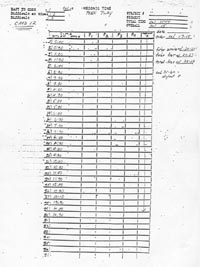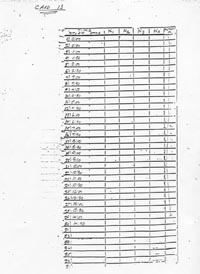Description of Test: This coding assesses the strength of positive and negative emotion during each of the observed situations. (Easterbrooks, A., & Emde, R. N. (1983). The Hedonic Tone Scales. Unpublished manuscript, University of Colorado Health Sciences Center, Denver.) To see the description of the Freeplay Procedure from the MALTS procedure document, move there. To see the form on which the data was recorded, click on the appropriate image below:

|

|
| Positive Hedonic Tone form |
Negative Hedonic Tone form |
Variable Names: Variable names from this database have the prefix V1HTF (from the Freeplay Hedonic Tone database). The Freeplay Hedonic Tone database includes 600 test subjects and 107 variables, and adds 6 composite scores and a comment field. Data were collected by viewing video tapes of the Freeplay Procedure at the 14 month home visit and recording positive and negative responses in incremental time intervals (30 second intervals). The variables include: Difficulty to Code Rating, Total Time (in seconds), Overall Mood Scale, Coder ID, Time (in seconds) till First Smile, Time (in seconds) till First Fret, Total Number of Frets, and a rating for positive and a rating for negative responses in up to 50 time intervals. Additionally, there are variables for the Start Time (in minutes and seconds) for the HTFRP14 data set, and 6 composite variables. Composite variables across both Bayley Hedonic Tone and Freeplay Hedonic Tone are documented under the Bayley Hedonic Tone page. Move there to move to the complete list of variable names from this database.
Cleaning: The data have been examined to ensure that the values of the variables are within range.
Composites: There are 6 composite variables: V1HTFAVP, V1HTFAVN, V1HTFSDP, V1HTFSDN, V1HTFAVL, and V1HTFSDL.
V1HTFAVP:
This variable is the average for the 50 positive ratings from the HTFRP14 database. If more than 6 items were missing in the data, the composite score was entered as missing.
V1HTFAVNL:
This variable is the average for the 50 negative ratings from the HTFRP14 database. If more than 6 items were missing in the data, the composite score was entered as missing.
V1HTFSDP:
This variable is the standard deviation of the 50 positive ratings for the HTFRP14 database. If more than 6 items were missing in the data, the composite score was entered as missing.
V1HTFSDN:
This variable is the standard deviation of the 50 negative ratings for the HTFRP14 database. If more than 6 items were missing in the data, the composite score was entered as missing.
V1HTFAVL:
This is a measure of the lability of the positive and negative responses. It was computed by first transforming the values of the variables, V1HTFRPP1-V1HTFRPP50 and V1HTFRPN1-V1HTFRPN50, from a scale of 1 to 4 into a scale of 0 to 3, and then adding the scores together. The resulting lability scores (50 for each data set) were then averaged to give an average lability score ranging from 0-6. The lability scores were not retained in the database. If more than 6 lability scores were missing in the data, the composite score was entered as missing.
V1HTFSDL:
This variable is the standard deviation for the 50 lability scores for the HTFRP14 database. If more than 6 lability scores were missing in the data, the composite score was entered as missing.
| Index of variable names and their labels | |
| Variable | Label |
| TWINID | Twin ID |
| V1HTFDIF | 14M HTFRP: Difficulty Code |
| V1HTFTTM | 14M HTFRP: Total time (seconds) |
| V1HTFOMS | 14M HTFRP: Overall Mood Scale |
| V1HTFCDR | 14M HTFRP: Coder ID |
| V1HTF1SM | 14M HTFRP: Latency to first smile (seconds) |
| V1HTF1FR | 14M HTFRP: Latency to first fret (seconds) |
| V1HTFTFR | 14M HTFRP: Total frets |
| V1HTFP1 | 14M HTFRP: Positive 1 |
| V1HTFP2 | 14M HTFRP: Positive 2 |
| V1HTFP3 | 14M HTFRP: Positive 3 |
| V1HTFP4 | 14M HTFRP: Positive 4 |
| V1HTFP5 | 14M HTFRP: Positive 5 |
| V1HTFP6 | 14M HTFRP: Positive 6 |
| V1HTFP7 | 14M HTFRP: Positive 7 |
| V1HTFP8 | 14M HTFRP: Positive 8 |
| V1HTFP9 | 14M HTFRP: Positive 9 |
| V1HTFP10 | 14M HTFRP: Positive 10 |
| V1HTFP11 | 14M HTFRP: Positive 11 |
| V1HTFP12 | 14M HTFRP: Positive 12 |
| V1HTFP13 | 14M HTFRP: Positive 13 |
| V1HTFP14 | 14M HTFRP: Positive 14 |
| V1HTFP15 | 14M HTFRP: Positive 15 |
| V1HTFP16 | 14M HTFRP: Positive 16 |
| V1HTFP17 | 14M HTFRP: Positive 17 |
| V1HTFP18 | 14M HTFRP: Positive 18 |
| V1HTFP19 | 14M HTFRP: Positive 19 |
| V1HTFP20 | 14M HTFRP: Positive 20 |
| V1HTFP21 | 14M HTFRP: Positive 21 |
| V1HTFP22 | 14M HTFRP: Positive 22 |
| V1HTFP23 | 14M HTFRP: Positive 23 |
| V1HTFP24 | 14M HTFRP: Positive 24 |
| V1HTFP25 | 14M HTFRP: Positive 25 |
| V1HTFP26 | 14M HTFRP: Positive 26 |
| V1HTFP27 | 14M HTFRP: Positive 27 |
| V1HTFP28 | 14M HTFRP: Positive 28 |
| V1HTFP29 | 14M HTFRP: Positive 29 |
| V1HTFP30 | 14M HTFRP: Positive 30 |
| V1HTFP31 | 14M HTFRP: Positive 31 |
| V1HTFP32 | 14M HTFRP: Positive 32 |
| V1HTFP33 | 14M HTFRP: Positive 33 |
| V1HTFP34 | 14M HTFRP: Positive 34 |
| V1HTFP35 | 14M HTFRP: Positive 35 |
| V1HTFP36 | 14M HTFRP: Positive 36 |
| V1HTFP37 | 14M HTFRP: Positive 37 |
| V1HTFP38 | 14M HTFRP: Positive 38 |
| V1HTFP39 | 14M HTFRP: Positive 39 |
| V1HTFP40 | 14M HTFRP: Positive 40 |
| V1HTFP41 | 14M HTFRP: Positive 41 |
| V1HTFP42 | 14M HTFRP: Positive 42 |
| V1HTFP43 | 14M HTFRP: Positive 43 |
| V1HTFP44 | 14M HTFRP: Positive 44 |
| V1HTFP45 | 14M HTFRP: Positive 45 |
| V1HTFP46 | 14M HTFRP: Positive 46 |
| V1HTFP47 | 14M HTFRP: Positive 47 |
| V1HTFP48 | 14M HTFRP: Positive 48 |
| V1HTFP49 | 14M HTFRP: Positive 49 |
| V1HTFP50 | 14M HTFRP: Positive 50 |
| V1HTFN1 | 14M HTFRP: Negative 1 |
| V1HTFN2 | 14M HTFRP: Negative 2 |
| V1HTFN3 | 14M HTFRP: Negative 3 |
| V1HTFN4 | 14M HTFRP: Negative 4 |
| V1HTFN5 | 14M HTFRP: Negative 5 |
| V1HTFN6 | 14M HTFRP: Negative 6 |
| V1HTFN7 | 14M HTFRP: Negative 7 |
| V1HTFN8 | 14M HTFRP: Negative 8 |
| V1HTFN9 | 14M HTFRP: Negative 9 |
| V1HTFN10 | 14M HTFRP: Negative 10 |
| V1HTFN11 | 14M HTFRP: Negative 11 |
| V1HTFN12 | 14M HTFRP: Negative 12 |
| V1HTFN13 | 14M HTFRP: Negative 13 |
| V1HTFN14 | 14M HTFRP: Negative 14 |
| V1HTFN15 | 14M HTFRP: Negative 15 |
| V1HTFN16 | 14M HTFRP: Negative 16 |
| V1HTFN17 | 14M HTFRP: Negative 17 |
| V1HTFN18 | 14M HTFRP: Negative 18 |
| V1HTFN19 | 14M HTFRP: Negative 19 |
| V1HTFN20 | 14M HTFRP: Negative 20 |
| V1HTFN21 | 14M HTFRP: Negative 21 |
| V1HTFN22 | 14M HTFRP: Negative 22 |
| V1HTFN23 | 14M HTFRP: Negative 23 |
| V1HTFN24 | 14M HTFRP: Negative 24 |
| V1HTFN25 | 14M HTFRP: Negative 25 |
| V1HTFN26 | 14M HTFRP: Negative 26 |
| V1HTFN27 | 14M HTFRP: Negative 27 |
| V1HTFN28 | 14M HTFRP: Negative 28 |
| V1HTFN29 | 14M HTFRP: Negative 29 |
| V1HTFN30 | 14M HTFRP: Negative 30 |
| V1HTFN31 | 14M HTFRP: Negative 31 |
| V1HTFN32 | 14M HTFRP: Negative 32 |
| V1HTFN33 | 14M HTFRP: Negative 33 |
| V1HTFN34 | 14M HTFRP: Negative 34 |
| V1HTFN35 | 14M HTFRP: Negative 35 |
| V1HTFN36 | 14M HTFRP: Negative 36 |
| V1HTFN37 | 14M HTFRP: Negative 37 |
| V1HTFN38 | 14M HTFRP: Negative 38 |
| V1HTFN39 | 14M HTFRP: Negative 39 |
| V1HTFN40 | 14M HTFRP: Negative 40 |
| V1HTFN41 | 14M HTFRP: Negative 41 |
| V1HTFN42 | 14M HTFRP: Negative 42 |
| V1HTFN43 | 14M HTFRP: Negative 43 |
| V1HTFN44 | 14M HTFRP: Negative 44 |
| V1HTFN45 | 14M HTFRP: Negative 45 |
| V1HTFN46 | 14M HTFRP: Negative 46 |
| V1HTFN47 | 14M HTFRP: Negative 47 |
| V1HTFN48 | 14M HTFRP: Negative 48 |
| V1HTFN49 | 14M HTFRP: Negative 49 |
| V1HTFN50 | 14M HTFRP: Negative 50 |
| V1HTFAVP | 14M HTFRP: Average positive responses |
| V1HTFAVN | 14M HTFRP: Average negative responses |
| V1HTFSDP | 14M HTFRP: Standard deviation of positive responses |
| V1HTFSDN | 14M HTFRP: Standard deviation of negative responses |
| V1HTFAVL | 14M HTFRE: Average lability |
| V1HTFSDL | 14M HTFRE: Standard deviation of lability |
Note: This coding is done from videotaped analysis of the child's face during the Freeplay portion of the Home Visit. The following procedure description is taken from the Freeplay description in the MALTS procedure document:
Free-play
This measure is assessed in the 14, 20, 24 and 36 month visits as well as the five year visit. The children are asked to go into a room with a door which the mother closed after joining the children. The examiners at 14, 20 and 24 month visits assembled twelve toys in a standardized array on the floor. Then the children and their mothers were called into the room. The mothers had been instructed not to label any of the toys for the children not to initiate any interaction with the twins. She could respond if approached by the children but interactions were to be kept to a minimum. Appreciation of standards as well as the twins methods of interacting with each other were assessed during this procedure. At ages 36 months, five and seven years, the children were given several vehicles animals and play school people to use in their free play. This measure at all ages was fifteen minutes in length.